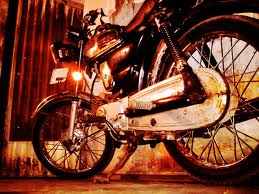Apart from where to arrange your bike finance, of course…
Before you buy a bike, the first thing is to learn to ride one. You will find motorbike training schools across the country. These come equipped with bikes to borrow as they train you.
Top Riding Tips*
We have researched the common top tips for riding a motorbike, so here are the commonly agreed top riding tips:
1. Keep your heels close into the bike, pressed against the side of the footplate. That leads to you riding loose on top – tight on bottom: Squeeze your thighs together to grip the tank, keeping the bottom half of your body strong and stable. Keep your upper body loose – check that by wriggling your elbows like a chook to loosen that death grip most new riders take on – which can end in disaster.
2. Taking turns can be tricky at first. The rule of thumb is to enter the turn from the outside – the wider side of the curve, then travel towards the inside of the curve, then travel out to the outside of the curve again. That lessens your lean angle so you’re less likely to slip and spin out.
3. If you want to stay on your bike through a turn – don’t brake. That means you have to be prepared and aware approaching a turn. If you are leaning as you enter a turn and brake, there is a high chance you will go over – especially if it has been raining and you are crossing painted lines. So brake before you enter a curve, lean forward and accelerate – slightly – through the turn.
4. The safety courses all stress that you must pay attention through all turns – looking through the turn – exaggerating how far you look as you turn as many new riders keep their eyes just in front of them which plays havoc with your body line and balance.
5. Keep your visor down. It might feel great to have the wind blowing in your eyes, but it is not so great when a bug flies into them.
6. Don’t think other cars know you are behind or beside them. Drivers are often talking on the phone, screaming at the kids, fiddling with food or daydreaming off with the pixies and have no idea you are near them.
7. Have an escape plan. This means you have to stay focused, always checking your alternative path – the trick is to always think the driver in the car near you is out to get you, and have an escape plan.
What are you going to wear?
It’s great to feel the sun rippling over your body as you fly down the highway. It’s not so great to feel the gravel grate along your chest as you scrape along the bitumen. There’s a reason all those bikie gangs wear those heavy leather jackets: it’s not just to look cool.
Bikie gangs usually have really strict rules about safety because they have hands-on experience of dealing with riders who crash. Jeff Cobb, editor and publisher of Motorcycle Safety News, a leading US motorcycle site says rider clothing keeps you protected from wind burn, sun burn, exhaust burns, and is a comfortable first line of defence. He says lots of riders have great jackets but wear jeans on the bottom.
In sunny Australia, riders can often be seen wearing shorts. He says the fact is, your legs are very vulnerable and should be protected.
“In a crash, cotton dungarees tear through in less than one second. Shorts, khakis or sweat pants offer negligible safety value. Fashion leather may shred as instantly as cloth. If you choose leather, make sure it’s suitable for motorcycle use,” he says.
He says you should choose high-tensile cowhide which has the most abrasion resistance and tear-through strength. For the heat of summer, manufacturers offer perforated leather or abrasion-resistant mesh. There are also several brands of textile jeans, if you absolutely don’t want the fully kitted look.
*The advice given here should not be relied upon exclusively in learning to ride a motorbike, these are only general tips. Aussie Bike Loans strongly recommends all riders attend professional motorbike rider training
Image credit: http://agung-chandra.deviantart.com/art/myFather-motorcycle-159492343





